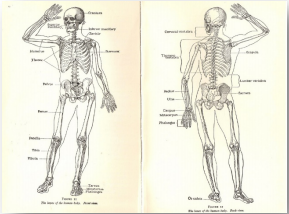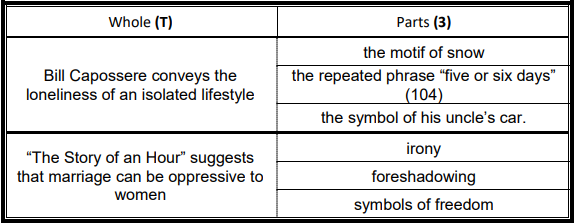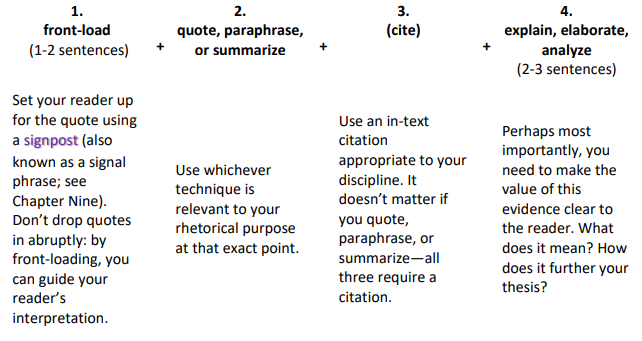2.3.2: Techniques
- Page ID
- 60216
Techniques
So What? Turning Observations into a Thesis
It's likely that you've heard the term "thesis statement" multiple times in your writing career. Even though you may have some idea what a thesis entails already, it is worth reviewing and unpacking the expectations surrounding a thesis, specifically in a text wrestling essay.
A thesis statement is a central, unifying insight that drives your analysis or argument. In a typical college essay, this insight should be articulated in one to three sentences, placed within the introductory paragraph or section. As we'll see below, this is not always the case, but it is what many of your audiences will expect. To put it simply, a thesis is the "So what?" of an analytical or persuasive essay. It answers your audience when they ask, Why does your writing matter? What bigger insights does it yield about the subject of analysis? About our world?
Thesis statements in most rhetorical situations advocate for a certain vision of a text, phenomenon, reality, or policy. Good thesis statements support such a vision using evidence and thinking that confirms, clarifies, demonstrates, nuances, or otherwise relates to that vision. In other words, a thesis is "a proposition that you can prove with evidence..., yet it's one you have to prove, that isn't obviously true or merely factual."76
In a text wrestling analysis, a thesis pushes beyond basic summary and observation. In other words, it's difference between:
| Observation | Thesis |
| What does the text say? | What do I have to say about the text? |
| I noticed ____________ |
I noticed ____________ and it means ____________ I noticed ____________ and it matters because ____________. |
If you think of your essay as the human body, the thesis is the spine. Yes, the body can still exist without a spine, but its functionings will be severely limited. Furthermore, everything comes back to and radiates out from the spine: trace back from your fingertips to your backbone and consider how they relate. In turn, each paragraph should tie back to your thesis, offering support and clear connections so your reader can see the entire "body" of your essay. In this way, a thesis statement serves two purposes: it is not only about the ideas of your paper, but also the structure.

"Vintage ephemera" by HA! Designs - Artbyheather is licensed under CC BY-NC-ND 2.0
The Purdue Online Writing Lab (OWL)77 suggests this specific process for developing your thesis statement:
- Once you've read the story or novel closely, look back over your notes for patterns of questions or ideas that interest you. Have most of your questions been about characters, how they develop or change?

If you are reading Conrad's The Secret Agent, do you seem to be most interested in what the author has to say about society? Choose a pattern of ideas and express it in the form of a question and an answer such as the following:
Question: What does Conrad seem to be suggesting about early twentieth-century London society in his novel The Secret Agent?
Answer
Conrad suggests that all classes of society are corrupt.
Pitfalls:
Choosing too many ideas
Choosing an idea without any support.
2. Once you have some general points to focus on, write your possible ideas and answer the questions that they suggest.
Question: How does Conrad develop the idea that all classes of society are corrupt?
Answer:
He uses images of beasts and cannabilism whether he's describing socialities, policemen, or secret agents.
3. To write your thesis statement, all you have to do is turn the question and answer around. You've already given the answer, now just put it in a sentence (or a couple of sentences) so that the thesis of your paper is clear.
In his novel, The Secret Agent, Conrad uses beast and cannibal imagery to describe the characters and their relationships. This pattern of images suggests that Conrad saw corruption in every level of early twentieth-century London society.
4. Now that you're familiar with the story or novel and have developed a thesis statement, you're ready to choose the evidence you'll use to support your thesis. There are a lot of good ways to do this, but all of them depend on a strong thesis for their direction.
Here's a student's thesis about Joseph Conrad's The Secret Agent.
In his novel, The Secret Agent, Conrad uses beast and cannibal imagery to describe the characters and their relationships to each other. This pattern of images suggests that Conrad saw corruption in every level of early twentieth-century London society.
This thesis focuses on the idea of social corruption and the device of imagery. To support this thesis, you would need to find images of beasts and cannibalism within the text.
There are many ways to write a thesis, and your construction of a thesis statement will become more intuitive and nuanced as you become a more confident and competent writer. However, there are a few tried-and-true strategies that I'll share with you over the next few pages.

The T3 Strategy
T3 is a formula to create a thesis statement. The T (for Thesis) should be the point you're trying to make- the "So what?" In a text wrestling analysis, you are expected to advocate for a certain interpretation of a text: this is your "So what?" Examples might include:
In "A Wing from the North," Bill Capossere conveys the loneliness of isolated life
or
Kate Chopin's "The Story of an Hour" suggests that marriage can be oppressive to women
But wait- there's more! In a text wrestling analysis, your interpretation must be based on evidence from that text. Therefore, your thesis should identify both a focused statement of the interpretation (the whole) and also the particular subjects of your observation (the partsof the text you will focus on support that interpretation). A complete T3 thesis statement for a text wrestling analysis might look more like this:
In "A Wing from the North," Bill Capossere conveys the loneliness of an isolated lifestyle using the motif of snow, the repeated phrase "five or six days" (104), and the symbol of his uncle's car.
or
"The Story of an Hour" suggests that marriage can be oppressive to women. To demonstrate this theme, Kate Chopin integrates irony, foreshadwoing, and symbols of freedom in the story.
Notice the way the T3 allows for the part-to-whole thinking that underlies analysis:

This is also a useful strategy because it can provide structure for your paper: each justifying support for your thesis should be one section of your paper.
I. Introduction
a. Thesis: In "A Wind from the North," Bill Capossere conveys the loneliness of an isolated lifestyle using the motif of snow, the repeated phrase "five or six days" (104), and the symbol of his uncle's car.
II. Section on 'the motif of snow.'
Topic sentence: The recurring imagery of snow creates a tone of frostiness and demonstrates the passage of time.
III. Section on 'the repeated phrase "five or six days" (104).'
Topic sentence: When Capossere repeats "five or six days" (104), he reveals the ambiguity of death in a life not lived.
IV. Section on 'the symbol of his uncle's car.'
Topic sentence: Finally, Capossere's uncle's car is symbolic of his lifestyle.
V. Conclusion
Once you've developed a T3 statement, you can revise it to make it feel less formulaic. For example:
In "A Wind from the North," Bill Capossere conveys the loneliness of an isolated lifestyle by symbolizing his uncle with a "untouchable" car. Additionally, he repeats images and phrases in the essay to reinforce his uncle's isolation.
or
"The Story of an Hour," a short story by Kate Chopin, uses a plot twist to imply that marriage can be oppressive to women. The symbols of freedom in the story create a feeling of joy, but the attentive reader will recognize the imminent irony.
The O/P Strategy
An occassion/position thesis statement is rhetorically convincing because it explains the relvance of your argument and concisely articulates that argument. Although you should already have your position in mind, your rhetorical occassion will lead this statement off: what sociohistorical conditons make your writing timely, relevant, applicable? Continuing with the previous examples:
As our society moves from individualism to isolationism, Bill Capossere's "A Wind from the North" is a salient example of a life lived alone.
or
Alothough Chopin's story was written over 100 years ago, it still provides insight to gender dynamics in American marriages.
Following your occasion, state your position- agaion, this is your "So What?" It is wise to include at least some preview of the parts you will be examining.
As our society moves from individualism to isolationism, Bill Capossere's "A Wind from the North" is a salient example of a life lived alone. Using recurring images and phrases, Capossere conveys the loneliness of his uncle leading up to his death
or
Although Chopin's story was written over 100 years ago, it still provides insight to gender dynamics in American marriages. "The Story of an Hour" reminds us that marraige has historically meant a surrender of freedom for women.
Research Question and Embedded Thesis
There's one more commons style of thesis construction that's worth noting, and that's the inquiry-based thesis. (Read more about inquiry-based research writing in Chapter Eight). For this thesis, you'll develop an incisive and focused question which you'll explore throughout the course of the esaay. By the end of the essay, you will be able to offer an answer (perhaps a complicated or incomplete answer, but still some kind of answer) to the question. This form is also referred to as the "embedded thesis" or "delayed thesis" organization.
Although this model of thesis can be effectively applied in a text wrestling essay, it is often more effective when combined with one of the other methods above.
Consider the following examples:
Bill Capossere's essay "A Wind from the North" suggests that isolation results in sorrow and loneliness; is this always the case? How does Capossere create such a vision of his uncle's life?
or
Many people would believe that Kate Chopin's story reflects an outdated perception of marriage- but can "The Story of an Hour" reveal power imbalances in modern relationships, too?

Synthesis: Using Evidence to Explore Your Thesis
Now that you've considered what your analytical insight might be (articulated in the form of a thesis), it's time to bring evidence in to support your analysis- this is the synthesis part of Bloom's Taxonomy earlier in this chapter. Synthesis refers to the creation of a new while (an interpretation) using smaller parts (evidence from the text you've analyzed).
There are essentially two ways to go about collecting and culling relevant support from the text with which you're wrestling. In my experience, students are split about evenly on which option is better for them:
Option #1: Before writing your thesis, while you're reading and rereading your text, annotate the page and take notes. Copy down quotes, images, formal features, and themes that are striking, exciting, or relatable. Then, try to group your collection of evidence according to common traits. Once you've done so, choose one or two groups on which to base your thesis.
or
Option #2: After writing your thesis, revisit the text looking for quotes, images, and themes that support, elaborate, or explain your interpretation. Record these quotes, and then return to the drafting process.
Once you've gathered evidence from your focus text, you should weave quotes, paraphrases, and summaries into your own writing. A common misconception is that you should write "around" your evidence, i.e. choosing the direct quote you want to use and building a paragraph around it. Instead, you should foreground your interpretation and analysis, using evidence in the background to explore and support that interpretation. Lead with your idea, then demonstrate it with evidence; then, explain how your evidence demonstrates your idea.
The appropriate ratio of evidence (their writing) to exposition (your writing) will vary depending on your rhetorical situation, but I advise my students to spend at least as many words unpacking a quote as that quote contains. (I'm referring here to Step #4 in the table below.) For example, if you use a direct quote of 25 words, you out to spend at least 25 words explaining how that quote supports or nuances your interpretation.
There are infinite ways to bring evidence into your discussion, 78 but for now, let's take a look at a formula that many students find productive as they find their footing in analytical wiriting: Front-load + Quote/Paraphrase/Summarize + Cite + Example/elaborate/analyze.

What might this look like in practice?
The recurring imagery of snow creates a tone of frostiness and demonstrates the passage of time. (1) Snow brings to mind connotations of wintery cold, quiet, and death (2) as a "sky of utter clarity and simplicity" lingers over his uncle's home and "it [begins] once more to snow" ((3) Capossere 104). (4) Throughout his essay, Capossere returns frequently to weather imagery, but snow especially, to play on associations the reader has. In this line, snow sets the tone by wrapping itself in with "clarity," a state of mind. Even though the narrator still seems ambivalent about his uncle, this clarity suggests that he is reflecting with a new and somber understanding.
1. Front-load
Snow brings to mind connotations of wintery cold, quiet, and death
2. Quote
as a "sly of utter clarity and simplicity" lingers over his uncle's home and "it [begins] once more to snow"
3. Cite
(Capossere 104)
4. Explain/elaborate/analysis
Throughout his essay, Capossere returns frequently to weather imagery, but snow especially, to play on associations the reader has. In this line, snow sets the tone by wrapping itself with "clarity," a state of mind. Even though the narrator still seems ambivalent about his uncle, this clarity suggests that he is reflecting with a new and somber understanding.
This might feel formulaic and forced at first, but following these steps will ensure that you give each piece of evidence between two slices of your own language and interpretation.

"The Biology of Human Sex Differences" by Reuben Strayer is licensed under CC BY-SA 2.0
For more on front-loading (readerly signposts or signal phrases), see the subsection titled "Readerly Signposts" in Chapter Nine.


